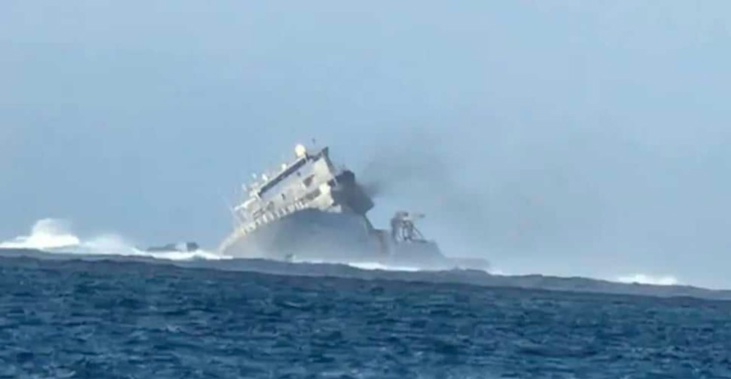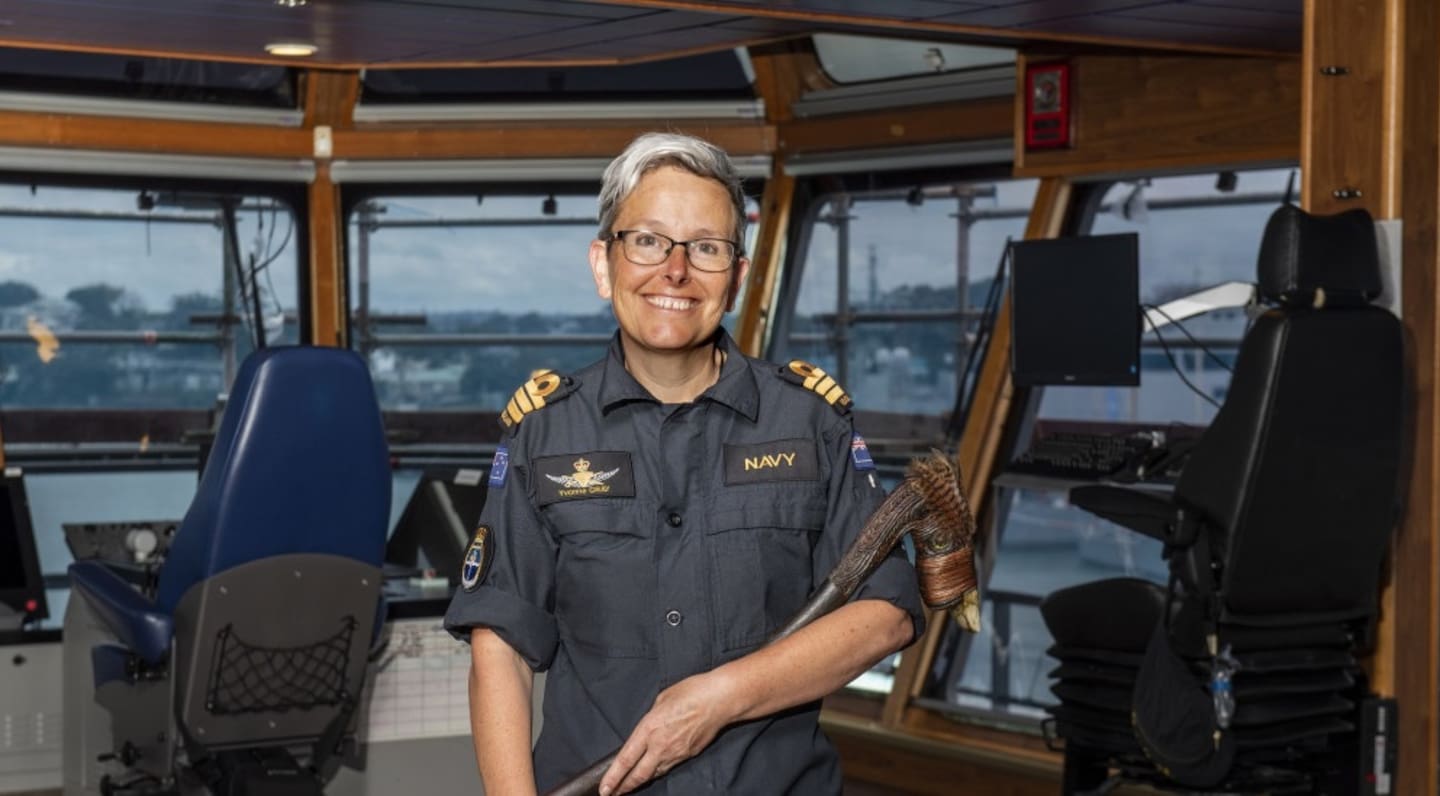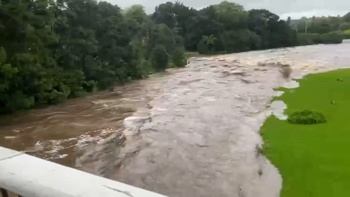
The captain of the doomed HMNZS Manawanui says the disaster was when her “very worst imagining became a reality”.
Commander Yvonne Gray was in charge of the $100 million New Zealand naval ship which ran aground on a reef off the coast of Samoa on Saturday.
Attempts to get the vessel off the reef were unsuccessful and when it began to list at 7.52pm, Commander Gray decided to evacuate the ship.
About an hour after all personnel on board were rescued at 5.35am on Sunday, the ship started to lean heavily on one side and smoke began pouring out.
At 9am, HMNZS Manawanui capsized and went below the surface near the southern coast of Upolu in Samoa where it now lies.
Most were evacuated from the life rafts onto rescuing ships but one small boat capsized on the reef, so the personnel walked to land.
Two people were hospitalised - one with a dislocated shoulder and one had a hurt back. Another 12-15 people suffered minor cuts and abrasions.
Commander Gray said her team “responded in exactly the way I needed them to”.
“They acted with commitment, with comradeship and, above all, with courage,” she said in a Defence Force statement on Tuesday night.
The disaster was when her “very worst imagining became a reality”.
Gray moved to New Zealand in 2012, after 19 years in the Royal Navy. She took the helm of the Manawanui in December 2022. It was her first ship command.
 When the Navy ship HMNZS Manawanui began to list on Saturday evening, Commander Yvonne Gray decided to evacuate the ship. Photo / NZ Defence Force
When the Navy ship HMNZS Manawanui began to list on Saturday evening, Commander Yvonne Gray decided to evacuate the ship. Photo / NZ Defence Force
Late on Monday night, 72 of the 75 crew and passengers rescued from Manawanui arrived back in New Zealand on board a RNZAF C-130J Hercules.
They were being provided welfare support and were reuniting with families on Tuesday afternoon.
In a press conference at the Devonport Naval Base on Sunday, Defence Minister Judith Collins said the fact that no one died was “something of a triumph frankly, given the very, very difficult circumstances”.
Collins said it was very dark with rough conditions during the evacuation.
Everyone stayed calm, which she put down to the professionalism, training and courage of the crew.
Holding back tears, Collins said it was a sad day for the Navy but everyone came through.
“This could have been a truly terrible day.”
Chief of Navy Rear Admiral Garin Golding said it was “too early to speculate” whether mechanical failure or human error were to blame.
A Court of Inquiry into the incident is in the process of being set up.
Defence Minister Judith Collins and Chief of Navy Rear Admiral Garin Golding fronted a media conference in Auckland on Sunday on the sinking of HMNZS Manawanui off the coast of southern Samoa. Photo / Alex Burton
Professor David Capie of the Victoria University of Wellington Centre for Strategic Studies said the loss of the Manawanui was a huge blow to what was already a small Navy.
“New Zealand’s Navy has been under huge pressure in the last few years because of a lack of people, especially in some highly skilled positions like senior maritime engineers,” he said in a statement released by the Science Media Centre.
“That’s meant we simply couldn’t put a lot of ships to sea.”
Professor Capie said New Zealand had six ships it could use before the loss of Manawanui.
“When you think about New Zealand’s enormous maritime environment and the increasing calls on the Defence Force for responding to disasters, fisheries patrols, as well as a much more challenging strategic environment, and you only have five ships, that’s a really concerning place to be.”
 Royal New Zealand Navy ship HMNZS Manawanui sank near Samoa. Photo / US Navy
Royal New Zealand Navy ship HMNZS Manawanui sank near Samoa. Photo / US Navy
Expert John Battersby told the Herald’s The Front Page podcast a new vessel sinking a few years into service was not a good look.
“We have to take that one on the chin. We have taken a hit here. We have lost a vessel in peacetime,” he said.
“It’s two weeks out from the Commonwealth Heads of Government Meeting that is going to be right where our vessel was.”
However, he said, losing a vessel in peacetime was not completely unknown.
“It’s inherently a risky thing to head out on the open sea and other navies have lost vessels in peacetime with far greater consequences.”
Finance Minister Nicola Willis told Newstalk ZB’s Jack Tame the costs were now about salvage and cleanup.
“The ship itself had the equivalent of third-party insurance to provide some cover for that salvage and clean up,” she said.
“The ship itself isn’t covered by insurance so obviously we will need to replace that capability in the future which will come with a cost.
“Historically, Royal New Zealand Navy vessels aren’t insured due to the prohibitive cost.”
Willis said she had been advised the insurance would provide “some cover” for the salvage and clean-up.
Collins earlier told Newstalk ZB’s Mike Hosking the details of the insurance were “commercially sensitive”.
 HMNZS Manawanui sank off the Samoan island of Upolu.
HMNZS Manawanui sank off the Samoan island of Upolu.
Meanwhile, Prime Minister Christopher Luxon has said he had talked to Samoa’s Acting Prime Minister, Tuala Tevaga Iosefo Ponifasio, as concerns rise in Samoa about oil spills and pollution from the vessel.
“Our focus now moves to making sure we can mitigate and minimise any environmental impacts.
“They welcomed any and all support we can offer, and that’s what we plan to do. We’re going to do everything it takes to make sure we do the best we can to minimise the environmental impacts.”
He said clean-up teams and spill kits were sent to Samoa on the C-130 that flew to Samoa on Sunday and more equipment and expertise was on the way.
He said Maritime New Zealand had “huge capacity and capability” and was also on the way to assist.
Luxon also said an inquiry into how the accident happened had been set up, and “that should be not speculation, but a facts-driven process”.
- NZ Herald
Take your Radio, Podcasts and Music with you









